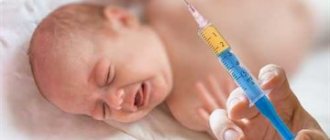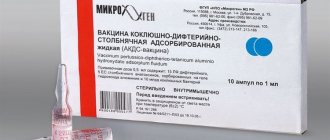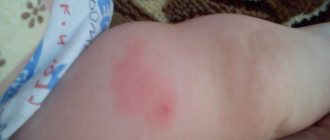DPT is a vaccine designed to provide protection against infection with pertussis germs, diphtheria and tetanus bacilli.
Any vaccination causes an immune response and may cause side effects. In this regard, DTP is considered the most reactogenic. Many babies develop unpleasant symptoms after the introduction of antigenic material.
It is important to know what kind of reaction the DTP vaccine can provoke in children and what to do if the drug is not suitable.
What are adverse reactions to vaccines?
The term “adverse reaction” refers to the occurrence of undesirable reactions of the body that were not the purpose of vaccination. In general, adverse reactions to vaccination are a normal reaction of the body to the introduction of a foreign antigen, and in most cases such a reaction reflects the process of developing immunity.
Adverse reactions are usually divided into local ones, i.e. occurring at the injection site (redness, soreness, thickening), and general, that is, those that affect the entire body as a whole - increased body temperature, malaise, etc.
In general, adverse reactions are a normal reaction of the body to the introduction of a foreign antigen and in most cases reflect the process of developing immunity. For example, the reason for the increase in body temperature that occurs after vaccination is the release of special “intermediaries” of the immune reaction into the blood. If the adverse reactions are not severe, then in general this is even a favorable sign in terms of developing immunity. For example, a small lump that appears at the site of vaccination with the hepatitis B vaccine indicates the activity of the process of developing immunity, which means that the vaccinated person will actually be protected from infection.
Naturally, an increase in body temperature to 40°C cannot be a favorable sign and such reactions are usually classified as a special type of severe adverse reactions. Such reactions, along with complications, are subject to strict reporting and must be reported to the authorities that control the quality of vaccines. If many such reactions occur to a given production batch of the vaccine, then such a batch is removed from use and is subject to repeated quality control.
Typically, adverse reactions to vaccinations with inactivated vaccines (DPT, DPT, hepatitis B) occur 1-2 days after vaccination and go away on their own, without treatment, within 1-2 days. After vaccination with live vaccines, reactions may appear later, on days 2-10, and also go away within 1-2 days without treatment.
Most vaccines have been used for decades, so the typicality of reactions should also be taken into account. For example, the rubella vaccine cannot cause gastritis, but at the same time it can cause short-term swelling of the joints.
The incidence of adverse reactions has also been well studied. It is no secret that the rubella vaccine, which has been used abroad for more than 30 years, causes approximately 5% of general reactions, and that the hepatitis B vaccine, which has been used for more than 15 years, causes about 7% of local reactions.
What vaccinations are given to children at 1 year of age and where?
The first year of a baby's life is the most difficult and eventful. You have to constantly visit the pediatrician. Either just a routine examination or another vaccination. And parents often feel that there will be no end to these trips to the clinic. And if up to a year, vaccination is done often, especially in the first six months. Then after 12 months you will only have to visit the vaccination office three times.
What vaccinations are given to children at 1 year of age and where? At this age, vaccination against measles, rubella and mumps is carried out.
It should be noted that a vaccinated child will not be a source of infection. The administered vaccine is safe for others. And those who have not had these illnesses should not be afraid of contacting a child. However, these drugs are safe for the baby himself. But it is necessary to have antipyretics and medications for allergic reactions at home.
The vaccination is done intramuscularly or subcutaneously. Most often it is injected into the shoulder, hip or subscapular region. It is important that the injection is made in a place where muscle tissue is well developed and the smallest layer of subcutaneous fat is present.
Why is the measles vaccine given at this age? Babies have residual protection against these diseases, which they receive from their mother. By about six months, the number of antibodies decreases significantly or disappears altogether. But studies have shown that only 60% of children vaccinated against measles have developed their own immunity. And at one year of age, immunity is formed in 100% of vaccinated patients. The body of children under five years of age is very susceptible to these diseases. Moreover, there are serious complications. Therefore, 1 year is the most optimal period for administering the measles-rubella-mumps vaccine.
If the vaccination was given at nine months of age, then the next vaccination should take place at 15-18 months. And you will have to be vaccinated 4-5 times, in accordance with the vaccination calendar. If the vaccination was given at the age of one, then the next time the measles vaccine will be administered only at 6 years of age and a total of 3-4 such vaccinations will be needed.
Therefore, it is very important to get vaccinated on time. Don't rush into it and don't delay it. The most favorable age for the measles, mumps and rubella vaccine is one year of age. But in some cases it needs to be done a month earlier, for example, if the child’s mother did not have her own immunity against these diseases.
You might also like:
Local reactions after vaccination
Local adverse reactions include redness, induration, soreness, swelling, which are significant and significant. Local reactions also include urticaria (an allergic rash, reminiscent of a nettle burn), and enlargement of the lymph nodes close to the injection site. Why do local reactions occur? As is known from biology textbooks for elementary school, when the skin is damaged and foreign substances enter the body, inflammation occurs at the site of entry. It is quite natural to assume that the greater the volume of foreign substances, the greater the severity of inflammation. Numerous clinical trials of vaccines involving control groups, when participants were given ordinary water for injection as a control drug, have shown that even to this “drug” local reactions occur, and with a frequency close to that for the experimental group where the vaccines were administered. That is, the cause of local reactions to a certain extent is the injection itself. Sometimes vaccines are designed to deliberately cause local reactions. We are talking about the inclusion in vaccines of special substances (usually aluminum hydroxide and its salts) or adjuvants, which are designed to cause inflammation so that more cells of the immune system “get acquainted” with the vaccine antigen, so that the strength of the immune response is higher. Examples of such vaccines are the DTP, ADS, and hepatitis A and B vaccines. Adjuvants are usually used in inactivated vaccines, since the immune response to live vaccines is already quite strong. The method of vaccine administration also affects the number of local reactions. All injectable vaccines are best administered intramuscularly, and not into the buttock (you can get into the sciatic nerve or subcutaneous fatty tissue). The muscles are much better supplied with blood, the vaccine is better absorbed, and the strength of the immune response is greater. In children under 2 years of age, the best place for vaccination is the anterolateral surface of the thigh in its middle third. For children over two years of age and adults, it is best to inject into the deltoid muscle of the shoulder, that same muscular thickening on the shoulder - the injection is done from the side, at an angle of 90 degrees to the surface of the skin. With subcutaneous administration of vaccines, the frequency of local reactions (redness, thickening) will obviously be higher, and the absorption of vaccines and, as a consequence, the immune response may be lower than with intramuscular administration.
General reactions after vaccinations
Common post-vaccination reactions include a rash covering large areas of the body, increased body temperature, anxiety, sleep and appetite disturbances, headache, dizziness, short-term loss of consciousness, cyanosis, cold extremities. In children, a reaction such as prolonged unusual crying occurs.
Why does a rash appear after vaccination? There are three possible reasons: reproduction of the vaccine virus in the skin, an allergic reaction, increased bleeding that occurs after vaccination. A mild, quick rash (caused by vaccine virus multiplication in the skin) is a normal consequence of vaccination with live virus vaccines such as measles, mumps, and rubella.
A pinpoint rash that occurs as a result of increased bleeding (for example, in rare cases, after a rubella vaccination there is a temporary decrease in the number of platelets) can reflect either a mild, temporary damage to the blood coagulation system, or be a reflection of a more serious pathology - for example, hemorrhagic vasculitis (autoimmune damage to the walls of blood vessels ) and can already be a post-vaccination complication.
When live vaccines are administered, it is sometimes possible to almost completely reproduce a natural infection in a weakened form. An illustrative example is vaccination against measles, when 5-10 days after vaccination a specific post-vaccination reaction is possible, characterized by an increase in body temperature, symptoms of acute respiratory infections, a peculiar rash - all this is classified as “vaccinated measles”.
Post-vaccination complications
Unlike adverse reactions, vaccination complications are unwanted and quite severe conditions that occur after vaccination. For example, a sharp drop in blood pressure (anaphylactic shock), as a manifestation of an immediate allergic reaction to any component of the vaccine, cannot be called either a normal adverse reaction or even a severe adverse reaction, since anaphylactic shock and collapse require resuscitation measures. Other examples of complications are seizures, neurological disorders, allergic reactions of varying severity, etc.
To be fair, it should be noted that, unlike adverse reactions, post-vaccination complications are extremely rare - the frequency of complications such as encephalitis due to measles vaccine is 1 in 5-10 million vaccinations, generalized BCG infection, which occurs when BCG is administered incorrectly, is 1 in 1 million vaccinations, vaccine-associated polio – 1 per 1-1.5 million OPV doses administered. With the infections themselves that vaccinations protect against, these same complications occur with an order of magnitude greater frequency (see adverse reactions and complications to specific types of vaccines).
Unlike post-vaccination reactions, complications rarely depend on the composition of vaccines and their main cause is considered to be:
- violation of vaccine storage conditions (overheating for a long time, hypothermia and freezing of vaccines that cannot be frozen);
- violation of the vaccine administration technique (especially important for BCG, which must be administered strictly intradermally);
- violation of instructions for administering the vaccine (from non-compliance with contraindications to the administration of an oral vaccine intramuscularly);
- individual characteristics of the body (unexpectedly strong allergic reaction to repeated administration of the vaccine);
- addition of infection - purulent inflammation at the injection site and infection during the incubation period of which the vaccination was carried out.
Local complications include compaction (over 3 cm in diameter or extending beyond the joint); purulent (in case of violation of vaccination rules) and “sterile” (incorrect administration of BCG) inflammation at the injection site.
Which vaccine should be used for revaccination in case of poor tolerability of DPT?
In case of allergies or other adverse reactions to DPT, vaccination against infection with diphtheria, tetanus and whooping cough is carried out with other drugs. There are means of domestic and foreign production.
Vaccine ADS-M
The Russian analogue of DTP is ADS-M. This drug differs from DTP in its less concentrated composition and the absence of a pertussis component. ADS-M should be used if a drug with a higher dosage provokes side effects. If you have an allergic reaction to DPT, it is better to use imported substitutes.
Typically, ADS-M is injected into weakened, premature and adult children. Also, the domestic analogue of DPT is Bubo-Kok. In addition to tetanus and diphtheria toxoids, whooping cough cells, this drug contains a hepatitis component.
Imported analogues of DTP:
- Pentaxim . This is a drug that is manufactured in France. In addition to protection against tetanus, diphtheria and whooping cough, it allows you to form specific immunity against Haemophilus influenzae and polio;
- Tetrakok . This is a French remedy. Contains tetanus toxoids, diphtheria, pertussis and polio components. Suitable for simultaneous vaccination with Haemophilus influenzae vaccine;
- Tritanrix NV . This is a vaccine that is produced in Belgium. Allows you to form protective forces against infection with whooping cough, diphtheria, tetanus and hepatitis B. In some regions of Russia there is a poor epidemiological situation with hepatitis. It is preferable for residents of such areas to be vaccinated with Tritanrix NV. The advantage of the drug is that it replaces two vaccinations;
- Infanrix . This is a Belgian vaccine. Most often, parents choose Infanrix as a substitute for DTP. This drug does not contain formaldehyde and merthiolate. Therefore, the vaccine is well tolerated.
Vaccine Infanrix
The advantages of using domestic vaccines are their availability and effectiveness. Imported analogues of DTP do not contain the whole-cell pertussis component, but its fragments, and therefore are better tolerated by children. Due to the high degree of purification, imported vaccinations are less likely to cause an allergic reaction.
But vaccination with such means is carried out on a paid basis. For example, immunoprophylaxis with Tetracok costs 850-1300, Pentaxim - 1050-1450, Infanrix - 1450-1800 rubles. Since the drugs are foreign, they may be subject to re-registration and may be temporarily unavailable for sale.
Common complications of vaccinations (vaccine):
- Excessively strong general reactions with high temperature rise (more than 40ºС), general intoxication
- Damage to the central nervous system: persistent high-pitched crying of the child, convulsions without and with fever; encephalopathy (appearance of neurological “signs”); post-vaccination serous meningitis (short-term, non-leaving “irritation” of the meninges caused by the vaccine virus);
- Generalized infection with a vaccine microorganism;
- Damage to various organs (kidneys, joints, heart, gastrointestinal tract, etc.);
- Allergic reactions: local allergic reactions (Quincke's edema), allergic rashes, croup, suffocation, temporary increased bleeding, toxic-allergic condition; fainting, anaphylactic shock.
- The combined course of the vaccination process and an associated acute infection, with or without complications;
Description of some complications
Anaphylactic shock after vaccination
Anaphylactic shock is an immediate allergic reaction, a state of sharply increased sensitivity of the body that develops with repeated introduction of an allergen. Usually to vaccine components (failure to comply with contraindications, undiagnosed allergies), it is characterized by a sharp drop in blood pressure and impaired cardiac activity. It usually occurs in the first 30 minutes after vaccination and requires resuscitation measures. In children, an analogue of anaphylaxis is collapse (fainting). It is an extremely rare complication. Anaphylactic shock often develops in children suffering from allergies and diathesis.
Afebrile seizures
Convulsions without an increase in body temperature (afebrile convulsions) - occur when vaccinated with DTP vaccines (1 per 30-40 thousand vaccinations). In contrast, febrile seizures (i.e., against the background of an increase in temperature) are caused by irritation of certain areas of the brain and meninges by vaccine antigens or a reaction to them. In some cases, seizures first detected after vaccination are a consequence of epilepsy.
How to care for your baby after vaccination?
- Caring for the baby after vaccination begins after leaving the treatment room. Don’t rush to go home - sit with your baby in the hallway, you can go outside and walk for half an hour near the clinic. It is in the first 30 minutes that there is a high risk of allergic reactions, and being close to the medical staff will help you react in time and help the baby.
- You can calm a crying baby by offering him a pacifier or bottled water. Experts recommend not feeding the baby for an hour before and after vaccination.
- During the adaptation period, if the baby does not have a fever, walk with him more often, but at the same time avoid crowded places where his body, weakened by the fight against pathogens, can easily become infected with ARVI and influenza.
- If even a slight fever appears (from 37.3), give the baby an antipyretic. You cannot give your baby medications “for prevention” after vaccination. If the baby has a high temperature, he should not be bathed until everything returns to normal. To maintain hygiene measures, use wet wipes.
- If there is no fever, the baby can be bathed as usual.
- The occurrence of skin reactions in the form of rashes and seals is not a contraindication to water procedures. The baby can and should be bathed.
- If there are no reactions, you cannot change your usual lifestyle: if the baby has a normal temperature, do not be afraid of anything. If you are used to walking twice a day, go for a walk; if your baby happily waits to be bathed every evening, fill the bathroom and go bathe your child. By giving up your usual activities when his temperature is normal, you can, on the contrary, harm your baby’s health.
- If the baby behaves rather sluggishly after vaccination, although his temperature is normal, do not try to bother him or entertain him in order to maintain the established daily routine, let the baby sleep and gain strength. For the same reason, do not stuff a baby without an appetite with food; if he hung on his chest for a short time, did not finish the formula from the bottle or complementary foods, it means he does not want to eat yet.
- Since all the forces of the baby’s body are aimed at fighting the pathogen, it does not need to be distracted by anything: it is forbidden to introduce new foods into the child’s diet for 2-3 days after vaccination.
- To ensure the accuracy of the data, you can keep a “vaccination” diary, which will note the baby’s temperature, the presence or absence of skin reactions, the facts of taking medications, and the general condition of the baby for 2 weeks after vaccination.











